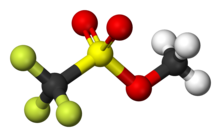Methyl trifluoromethanesulfonate
 | |
 | |
| Names | |
|---|---|
| Preferred IUPAC name Methyl trifluoromethanesulfonate | |
| Other names Trifluoromethanesulfonic acid, methyl ester Triflic acid, methyl ester, methyl triflate | |
| Identifiers | |
CAS Number |
|
3D model (JSmol) |
|
| ChemSpider |
|
| ECHA InfoCard | 100.005.793 |
| EC Number |
|
PubChem CID |
|
| UNII |
|
| UN number | 2924 |
CompTox Dashboard (EPA) |
|
InChI
| |
| |
| Properties | |
Chemical formula | C2H3F3O3S |
| Molar mass | 164.10 g·mol−1 |
| Appearance | Colourless Liquid |
| Density | 1.496 g/mL |
| Melting point | −64 °C (−83 °F; 209 K) |
| Boiling point | 100 °C (212 °F; 373 K) |
Solubility in water | Hydrolyzes |
| Hazards[1] | |
| Occupational safety and health (OHS/OSH): | |
Main hazards | Corrosive |
| GHS labelling: | |
| Danger | |
Hazard statements | H226, H301, H311, H314, H330 |
Precautionary statements | P210, P233, P303+P361+P353, P304+P340+P310, P305+P351+P338, P380 |
| Flash point | 38 °C (100 °F; 311 K) |
| Related compounds | |
Related compounds | Methyl fluorosulfonate |
Except where otherwise noted, data are given for materials in their standard state (at 25 °C [77 °F], 100 kPa).  Y verify (what is Y verify (what is  Y Y N ?) N ?) Infobox references | |
Methyl trifluoromethanesulfonate, also commonly called methyl triflate and abbreviated MeOTf, is the organic compound with the formula CF3SO2OCH3. It is a colourless liquid which finds use in organic chemistry as a powerful methylating agent.[2] The compound is closely related to methyl fluorosulfonate (FSO2OCH3). Although there has yet to be a reported human fatality, several cases were reported for methyl fluorosulfonate (LC50 (rat, 1 h) = 5 ppm), and methyl triflate is expected to have similar toxicity based on available evidence.[3][verification needed]
Synthesis
Methyl triflate is commercially available, however it may also be prepared in the laboratory by treating dimethyl sulfate with triflic acid.[4]
- CF3SO2OH + (CH3O)2SO2 → CF3SO2OCH3 + CH3OSO2OH
Reactivity
Hydrolysis
Upon contact with water, methyl triflate loses its methyl group, forming triflic acid and methanol:
- CF3SO2OCH3 + H2O → CF3SO2OH + CH3OH
Methylation
One ranking of methylating agents is (CH3)3O+ > CF3SO2OCH3 ≈ FSO2OCH3 > (CH3)2SO4 > CH3I.[4] Methyl triflate will alkylate many functional groups which are very poor nucleophiles such as aldehydes, amides, and nitriles. It does not methylate benzene or the bulky 2,6-di-tert-butylpyridine.[2] Its ability to methylate N-heterocycles is exploited in certain deprotection schemes.[5]
Cationic polymerization
Methyl triflate initiates the living cationic polymerization of lactide[6] and other lactones including β-propiolactone, ε-caprolactone and glycolide.[7]

Cyclic carbonates like trimethylene carbonate and neopentylene carbonate (5,5-dimethyl-1,3-dioxan-2-one) can be polymerized to the corresponding polycarbonates.[8] 2-alkyl-2-oxazolines, for example 2-ethyl-2-oxazoline, are also polymerized to poly(2-alkyloxazoline)s.[9]
Applications
Radiochemistry
Carbon-11 methyl triflate ([11C]MeOTf[10]), or methyl triflate containing the carbon-11 isotope, is commonly used in radiochemistry to synthesize radioactively labeled compounds that can be traced in living organisms using positron emission tomography (PET). For example, [11C]MeOTf has been used extensively in the production of Pittsburgh Compound B, which first allowed β-amyloid plaques to be imaged in a living brain.
See also
References
- ^ "Methyl trifluoromethanesulfonate". Sigma-Aldrich. Retrieved 31 October 2021.
- ^ a b Alder, Roger W.; Phillips, Justin G. E.; Huang Lijun; Huang Xuefei (2005). "Methyltrifluoromethanesulfonate". Encyclopedia of Reagents for Organic Synthesis. doi:10.1002/047084289X.rm266m.pub2. ISBN 0471936235.
- ^ Alder, R. W.; Sinnott, M. L.; Whiting, M. C.; Evans, D. A. (1978). "Hazards of powerful methylating agents". Chemistry in Britain. Vol. 14, no. 7. p. 324. Miscited as ——— (1976) Chem. Eng. News, vol. 54, no. 36, p. 56 in Alder et al. 2005
- ^ a b Stang, Peter J.; Hanack, Michael; Subramanian, L. R. (1982). "Perfluoroalkanesulfonic Esters: Methods of Preparation and Applications in Organic Chemistry". Synthesis. 1982 (2): 85–126. doi:10.1055/s-1982-29711. ISSN 0039-7881.
- ^ Albert I. Meyers & Mark E. Flanagan (1998). "2,2′-Dimethoxy-6-formylbiphenyl". Organic Syntheses; Collected Volumes, vol. 9, p. 258.
- ^ Rangel, Irma; Ricard, Michèle; Ricard, Alain (1994). "Polymerization of L-lactide and ε-caprolactone in the presence of methyl trifluoromethanesulfonate". Macromolecular Chemistry and Physics. 195 (9): 3095–3101. doi:10.1002/macp.1994.021950908.
- ^ Jonté, J. Michael; Dunsing, Ruth; Kricheldorf, Hans R. (1985). "Polylactones. 4. Cationic Polymerization of Lactones by Means of Alkylsulfonates". Journal of Macromolecular Science: Part A - Chemistry. 22 (4): 495–514. doi:10.1080/00222338508056616. ISSN 0022-233X.
- ^ Kricheldorf, Hans R.; Weegen-Schulz, Bettina; Jenssen, Jörg (1998). "Cationic polymerization of aliphatic cyclocarbonates". Macromolecular Symposia. 132 (1): 421–430. doi:10.1002/masy.19981320139.
- ^ Glassner, Mathias; D’hooge, Dagmar R.; Young Park, Jin; Van Steenberge, Paul H.M.; Monnery, Bryn D.; Reyniers, Marie-Françoise; Hoogenboom, Richard (2015). "Systematic investigation of alkyl sulfonate initiators for the cationic ring-opening polymerization of 2-oxazolines revealing optimal combinations of monomers and initiators". European Polymer Journal. 65: 298–304. doi:10.1016/j.eurpolymj.2015.01.019. hdl:1854/LU-5924229.
- ^ Jewett, D. M. (1992). "A simple synthesis of [11C]methyl triflate". International Journal of Radiation Applications and Instrumentation, Part A. 43 (11): 1383–1385. doi:10.1016/0883-2889(92)90012-4. hdl:2027.42/29777. ISSN 0883-2889. PMID 1333459.












